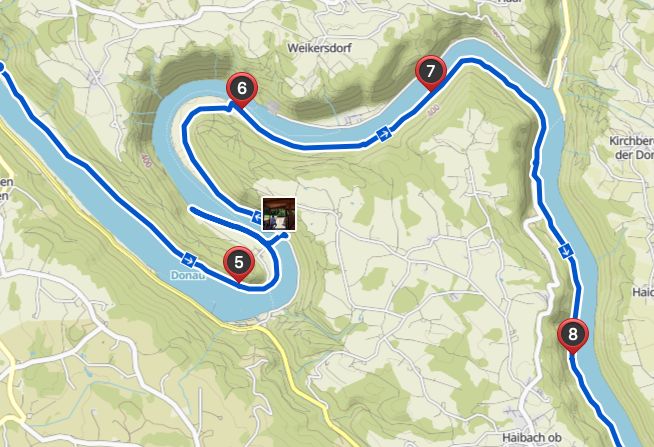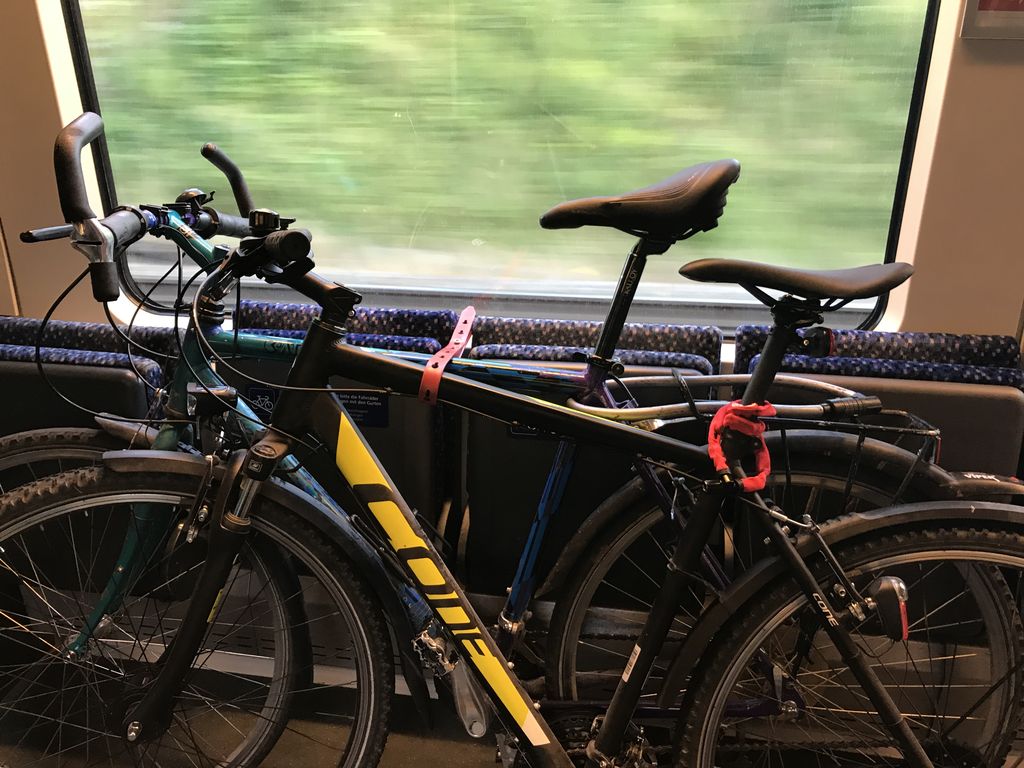This is a guest post written by Max, a friend of 82RPM from Germany.
Moving time: 4:49:43 – Distance: 99.9km – Climbing: 87m
The EV6 bicycle route from Passau to Linz along the Danube river is part of a network of routes connecting various cities across Germany, Austria, Slovakia, Hungary, and beyond. Several of these routes converge in the city of Passau, where the Inn and Ilz join the Danube. This tour starts precisely at the convergence of these three rivers, and heads downstream in a South-East direction.

View over the Danube, before convergence with Inn and Ilz, with Passau in the back.
For most of the route, cyclists have the choice to ride on both sides of the Danube river. Each side has its pro and cons, but both are well maintained, paved, and flat. Note that during the 100km between Passau and Linz there are limited options for changing the side of the river. I counted only three bridges and a handful of ferry lines where to cross.
If you follow the north side of the Danube, as we did, you will ride about 30km on German territory before reaching the border with Austria at Jochenstein. However, if you ride on the south side, you will enter Austria very early, after about 5km after Passau. The first 15km of the bicycle lane that we followed are next to a busy road. After Obernzell, traffic became less busy. Having crossed the border at Jochenstein, we arrived at Niederranna after another 5km. After crossing Niederranna, it is possible to switch riverside for the first time since Passau via a bridge. If you want to avoid having to take a ferry later on –in order to save time and money– you should take the bridge in Niederranna.

After Niederranna, we rode on the northern riverside of the Danube for another 9 km. ‘Über Fähren’ literally means ‘over ferries’
After Niederranna, the bikeway on the north riverside becomes increasingly remote and beautiful. If you do not mind riding a ferry, it is probably a good idea not to cross the bridge after Niederranna.
There are a number of small ‘restaurants’ along the bikeway that offer a selected choice of simple dishes and the usual menu of cold beverages (beer, soda) as well as ‘Most‘, an Austro-Bavarian type of cider. After another 8km, we arrived at the Loop of Schlögen (Schlögener Schlinge), where the Danube takes a number of turns, making for beautiful scenery.
As you can see from the map, we made a short detour because we did not notice the signs that were telling us that the bikeway was going to end. Fortunately, we had to go back only about 1km to the next ferry, which charged us 2 Euro per person and bike. The ride across the river was also a welcome break.
We continued on the south-west riverside of the Danube and after 14 km arrived at the Kraftwerk Aschach Dam. We took our first and only real break in Aschach, 70km into the trip. Aschach is not particularly picturesque, but it boasts a solid choice of restaurants, cafes, and a supermarket, enabling cyclists to stock up on water and energy bars.
After 14km from Aschach, we arrived at the Ottensheim-Wilhering hydropower plant, which also functions as bridge. Here there are signs warning cyclists that the route to Linz follows the north shore of the river. Hoeverm it is possible to proceed another 2 km on the right side; this option is also 2-3 km shorter but will necessitate the services of another ferry. We took our chances with the shorter bikeway and ended up in Willhering Ufer, where we boarded a ferry for 3,70 Euro per person and bicycle. The cruise was, however, less scenic than the one at the Loop of Schlögen. The ferry arrived at Ottensheim, where we took a last break before riding the final 10km to Linz. Again there are a number of restaurants and cafes at the riverside.

Ferry from Willhering Ufer to Ottensheim
The final 10km were, for the most part, along a very busy road with only a very narrow bikeway next to it. Especially the first 5km from Ottensheim to Puchenau were quite unpleasant. After Puchenau, the bikeway improves a bit thanks to a broader, dedicated lane. We finally reached the northwestern edge of Linz, where there are several restaurants next to beach parks. Yes, it is possible to swim in Linz.
Due to the Corona-Pandemic, ship services up and down the river do not operate. Under normal circumstances, cyclists can proceed via ship down the Danube to Vienna or further, or go back up again, to Passau or Regensburg.
With no ships operating, the alternative, short of cycling back, is to take the train. We proceeded through the old-town to Linz central station, bought one-way tickets back to Passau, and attended dinner before boarding the 1.5 hour train ride back to Passau. Note: if you plan to use the faster bullet train ICE, remember to book online a space for you bicycle in advance. If you do not reserve a space for your bike, you will have to use the ticket machine at the station, that only sell tickets of regional express trains, which are slightly cheaper but take longer.










